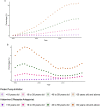Trends in acid suppressant drug prescriptions in primary care in the UK: a population-based cross-sectional study
- PMID: 33293322
- PMCID: PMC7722810
- DOI: 10.1136/bmjopen-2020-041529
Trends in acid suppressant drug prescriptions in primary care in the UK: a population-based cross-sectional study
Abstract
Objective: To examine proton pump inhibitor (PPI) and histamine-2 receptor antagonist (H2RA) prescribing patterns over a 29-year period by quantifying annual prevalence and prescribing intensity over time.
Design: Population-based cross-sectional study.
Setting: More than 700 general practices contributing data to the UK Clinical Practice Research Datalink (CPRD).
Participants: Within a cohort of 14 242 329 patients registered in the CPRD, 3 027 383 patients were prescribed at least one PPI or H2RA from 1 January 1990 to 31 December 2018.
Primary and secondary outcome measures: Annual prescription rates were estimated by dividing the number of patients prescribed a PPI or H2RA by the total CPRD population. Change in prescribing intensity (number of prescriptions per year divided by person-years of follow-up) was calculated using negative binomial regression.
Results: From 1990 to 2018, 21.3% of the CPRD population was exposed to at least one acid suppressant drug. During that period, PPI prevalence increased from 0.2% to 14.2%, while H2RA prevalence remained low (range: 1.2%-3.4%). Yearly prescribing intensity to PPIs increased during the first 15 years of the study period but remained relatively constant for the remainder of the study period. In contrast, yearly prescribing intensity of H2RAs decreased from 1990 to 2009 but has begun to slightly increase over the past 5 years.
Conclusions: While PPI prevalence has been increasing over time, its prescribing intensity has recently plateaued. Notwithstanding their efficacy, PPIs are associated with a number of adverse effects not attributed to H2RAs, whose prescribing intensity has begun to increase. Thus, H2RAs remain a valuable treatment option for individuals with gastric conditions.
Keywords: epidemiology; gastroduodenal disease; primary care.
© Author(s) (or their employer(s)) 2020. Re-use permitted under CC BY-NC. No commercial re-use. See rights and permissions. Published by BMJ.
Conflict of interest statement
Competing interests: None declared.
Figures




References
-
- Connelly D. The development and safety of proton pump inhibitors. The Pharm J 2016;296.
Publication types
MeSH terms
Substances
Grants and funding
LinkOut - more resources
Full Text Sources
Miscellaneous
